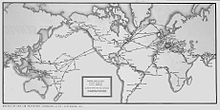Lajes Field
| Lajes Field Aerogare Civil das Lajes |
|
|---|---|

|
|
| Characteristics | |
| ICAO code | LPLA |
| IATA code | TER |
| Coordinates | |
| Height above MSL | 55 m (180 ft ) |
| Basic data | |
| opening | 1930 as Aeródromo da Achada |
| operator |
|
| Start-and runway | |
| 15/33 | 3314 m × 60 m asphalt |
Lajes Field or Lajes Air Base ( IATA code TER , ICAO code LPLA , port .: Base Aérea das Lajes or Base Aérea Nº 4 (BA4)) is a military airfield of the Portuguese Air Force on the Azores island of Terceira near the village of Lajes . The airport is located in the northeast of the island.
Lajes Field is also used by other NATO - air forces used mainly by the "65th Air Base Wing" of the United States Air Forces in Europe (USAFE). Until April 2011, Portugal was represented with the “Esquadra 752”, a “ Search and Rescue ” helicopter squadron.
As the only airport on the island, it is also used by civil aviation and is an alternate airport for transatlantic flights. The space shuttle could also have landed here in an emergency.
history
In 1928, under the military direction of Salvador Alberto du Courtiils Cifka Duarte (Air Force Inspector), the planning of the military airfield arose. The airfield in an extensive area of grassland (Lajes Field) was laid out and asphalted in 1929 with a length of 600 meters and a width of 70 meters right next to an army road. The inauguration of the airfield with the name "Aeródromo da Achada" took place on October 4th 1930. The military pilot Federico Coelho de Melo (1895-1971) landed there under the eyes of hundreds of viewers with a double-decker type Avro 504 K , with a 9-cylinder rotary engine of 110 hp of Gnôme Rhone- equipped.
Lajes Field played a special role in World War II : Due to the short range of the aircraft at that time, they needed refueling stops on the way from the USA to Europe and back. The special location of the Azores in the Atlantic, 3,680 kilometers east of New York and 1,600 kilometers west of Lisbon, made them strategically interesting. The use of Lajes Field reduced the flight time from 70 to 40 hours.
The British government negotiated with neutral Portugal in 1943, invoking the Anglo-Portuguese alliance of 1373. The British armed forces in turn concluded an agreement with the US military, which could now also use the base. So there was a strong expansion of Lajes Field by January 1944, including the installation of an A-shaped system of three runways. The runway, which runs parallel to the coastline and is still in use today, was then the longest runway in the world at over 10,000 feet (3,313 m). In June 1944, during Operation Overlord , 600 planes landed; the total number of flights from 1943 to 1945 was 8,689, including over 1,000 B-17 and B-24 bombers. In 1946 the military base was returned to Portugal, later used again by the USAF during the Cold War .
The airfield also gained greater importance for the American armed forces again in 1973, when supply flights for the Israeli armed forces were handled over the field as part of Operation Nickel Grass .
Airlines and Destinations
The airport of the island of Terceira is served by some civil airlines. TAP Air Portugal flies via Lisbon, SATA Air Açores serves the neighboring islands of Flores , Graciosa , Horta , Pico , São Miguel and São Jorge . SATA International flies to Boston, Oakland, Montreal and Toronto (as of September 2015), Travel Service from Prague to Miami (from December 19, 2012). The civil terminal is in the south of the airport.
The place received national attention in 2001 through the emergency landing of an Airbus A330 ( Air-Transat-Flight 236 ).
Web links
Individual evidence
- ↑ Helicópteros "Puma" regressam às Lajes. Retrieved December 16, 2009 (Portuguese).
- ^ Report on the reversal of a flight on spiegel.de from March 6, 2012 , accessed on March 6, 2012
- ↑ História dos Açores, with pictures from the first flight in 1930
- ↑ Air Force History Page ( Memento March 28, 2016 in the Internet Archive ), accessed February 22, 2011
- ↑ Sata Internacional Routes , sata.pt, accessed on September 13, 2015
